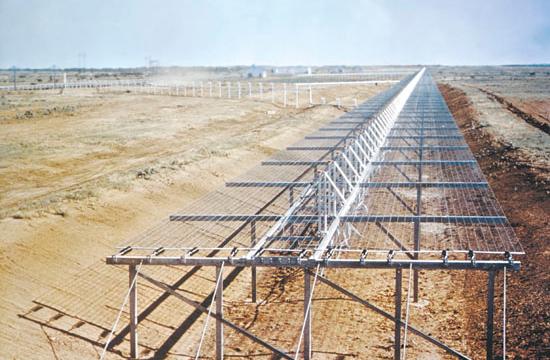In the 1980s, the US Air Force only knew about roughly 5000 pieces of space debris orbiting our planet. By 2010, that number had tripled to 15,639 objects. And our current space trash tracking system can’t even detect some of the smaller bits zipping around up there. That’s why the USAF is developing a new iteration of the venerable “Space Fence” that’s both more precise and more cost effective than its predecessor.
The space fence, technically known as the Air Force Space Surveillance System, is a multi-station radar system that detects objects in space as they pass over America. Commanded from the US Air Force Material Command’s Electronic Systems Center at Hanscom Air Force Base in Massachusetts, the Space Fence is a component of the US Space Surveillance Network (SSN), which is charged with spotting, tracking, and warning of trash falling out of the sky.
Currently, the space fence comprises of nine radar stations — three transmitters, six receivers — spread out along the 33rd parallel north from Georgia to California. These transmitters form a narrow band of energy extending out into space and are triggered every time an object breaks the radio barrier. The current system can detect an object as small as four inches in diameter from as high up as 15,000 nautical miles.

The next generation of the space fence, which is valued at about $US6.1 billion, is expected to utilise the more precise S-band frequency range, which will enable it to spot and track even smaller microsatellites in both low and medium Earth orbits, from as few as 2 or 3 radar installations.
As John Morse, Space Fence Program Manager, Lockheed Martin MS2 Radar Systems explained in a press statement:
The new Space Fence will be located in geographically dispersed areas to give us better coverage in the Southern Hemisphere in particular. It will also enhance the space situational awareness by being able to see smaller objects…Space Fence will be a system of systems that consists of 2 to 3 large S-band radars and those radars will join other sensors in the space surveillance network and provide space situational awareness to the Air Force…The scope of the Space Fence contract includes sensors, mission processing, data processing, facilities, and communications, the whole system requirement…In order to use the space domain, we need to have accurate space situational awareness…We need to know where things are so we can use space when and how we need to use it. So the military application can be summed as giving the Air Force enhanced space situational awareness.
Both Lockheed Martin and Raytheon have submitted designs for the replacement system to the DoD in hopes of landing that $US3.5 billion initial contract. The system was originally slated for deployment in 2015, however those plans have been delayed until at least 2017 on account of a Pentagon review of its acquisition programs.
Essentially, the DoD is taking a second look at which programs it will award priority to and isn’t handing out checks until its done. The Department of Defence had just better hurry up before another Russian comm satellite smashes into one of our own and rains a fiery hellstorm of satellite carnage down over Cleveland. [Defence Industry Daily – Lockheed Martin – Wikipedia – Space News –USAF]
